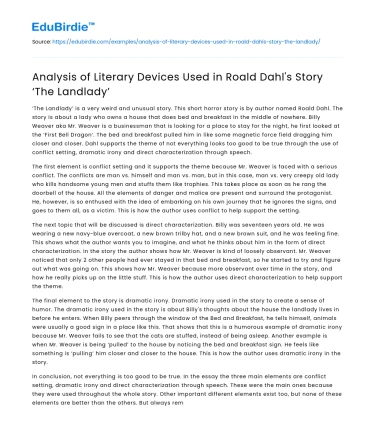‘The Landlady’ is a very weird and unusual story. This short horror story is by author named Roald Dahl. The story is about a lady who owns a house that does bed and breakfast in the middle of nowhere. Billy Weaver aka Mr. Weaver is a businessman that is looking for a place to stay for the night, he first looked at the ‘First Bell Dragon’. The bed and breakfast pulled him in like some magnetic force field dragging him closer and closer. Dahl supports the theme of not everything looks too good to be true through the use of conflict setting, dramatic irony and direct characterization through speech.
The first element is conflict setting and it supports the theme because Mr. Weaver is faced with a serious conflict. The conflicts are man vs. himself and man vs. man, but in this case, man vs. very creepy old lady who kills handsome young men and stuffs them like trophies. This takes place as soon as he rang the doorbell of the house. All the elements of danger and malice are present and surround the protagonist. He, however, is so enthused with the idea of embarking on his own journey that he ignores the signs, and goes to them all, as a victim. This is how the author uses conflict to help support the setting.
Save your time!
We can take care of your essay
- Proper editing and formatting
- Free revision, title page, and bibliography
- Flexible prices and money-back guarantee
The next topic that will be discussed is direct characterization. Billy was seventeen years old. He was wearing a new navy-blue overcoat, a new brown trilby hat, and a new brown suit, and he was feeling fine. This shows what the author wants you to imagine, and what he thinks about him in the form of direct characterization. In the story the author shows how Mr. Weaver is kind of loosely observant. Mr. Weaver noticed that only 2 other people had ever stayed in that bed and breakfast, so he started to try and figure out what was going on. This shows how Mr. Weaver because more observant over time in the story, and how he really picks up on the little stuff. This is how the author uses direct characterization to help support the theme.
The final element to the story is dramatic irony. Dramatic irony used in the story to create a sense of humor. The dramatic irony used in the story is about Billy's thoughts about the house the landlady lives in before he enters. When Billy peers through the window of the Bed and Breakfast, he tells himself, animals were usually a good sign in a place like this. That shows that this is a humorous example of dramatic irony because Mr. Weaver fails to see that the cats are stuffed, instead of being asleep. Another example is when Mr. Weaver is being ‘pulled’ to the house by noticing the bed and breakfast sign. He feels like something is ‘pulling’ him closer and closer to the house. This is how the author uses dramatic irony in the story.
In conclusion, not everything is too good to be true. In the essay the three main elements are conflict setting, dramatic irony and direct characterization through speech. These were the main ones because they were used throughout the whole story. Other important different elements exist too, but none of these elements are better than the others. But always remember that not everything is going to be true.






 Stuck on your essay?
Stuck on your essay?

